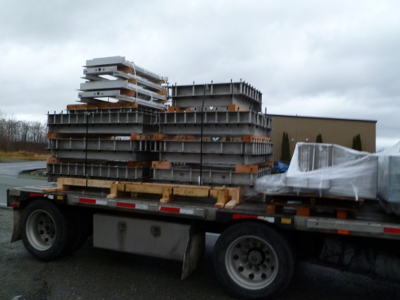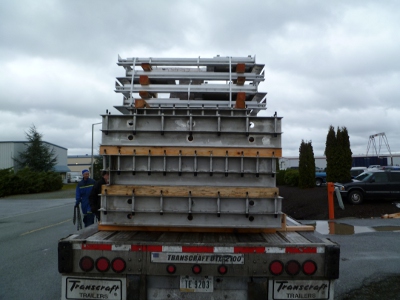| Home |
|
|
|
|
Online Store |

|
|
|
Next presentation ➙ "Controlling Your Surges" | Iowa Section AWWA Spring Short Course | Ankeny, Iowa | March 6, 2024
State of Minnesota sues 3M over water contamination
January 3, 2011
Minnesota's attorney general has filed a lawsuit against 3M, alleging that the company polluted groundwater and surface waters near the Twin Cities with perfluorochemicals (PFCs) used in the company's stain repellents. The attorney general claims that the pollution went on for 50 years. 3M is a major employer in Minnesota, having started in 1902 as Minnesota Mining and Manufacturing Co. in Duluth. It's the 5th-largest company headquarted in the state as measured by revenues and the tenth-biggest employer in the state. The news is of particular interest to us because the state claims that the contaminated waterways included the Mississippi River, which forms the eastern border of the state of Iowa.
We can help you with products for treating industrial wastewater. Please feel free to contact us with your questions.
When steel costs more, blame flooding in Australia
January 4, 2011
Exceptional flooding in Australia has done serious damage to mining regions in Queensland (the northeastern portion of the country). In addition to affecting an estimated 200,000 people directly, the flooding has closed 75% of the region's coal mines, which produce half of the coal used in the world for making steel. That's undoubtedly going to push up steel prices, at least in the short term. Considering the amount of steel that's used in everything from stainless steel sluice gates to the piping used for aeration systems, and even in pump station control panels, we're going to keep a very close eye on the situation.
What's in bottled water?
January 6, 2011
It's an excellent question: What's in bottled water? It's marketed and sold as though it's a premium beverage, but the people who work hard every day to deliver safe, clean municipal drinking water generally believe they're producing water of equivalent quality or better -- held to higher regulatory standards -- at a fraction of the price.
More floods, more often
January 7, 2011
A report sent to the governor and Iowa legislature this week says that Iowa is already being affected by changes in the climate that are causing summer storms to become more intense, leading to more serious and more frequent flooding, as well as increased water pollution from runoff. The report notes that autumns have become significantly drier and springs significantly wetter over the last century or so, and the trend appears to be continuing. As the report notes, the changes are occuring, whether they're caused by human behavior or not, and as a result, everyone ought to be able to agree that some measures need to be taken to mitigate the impact -- whether or not there is agreement on whether to mitigate the cause.
The effects are largely concentrated in areas of specific concern to our industry, with stormwater control equipment and municipal water treatment requiring particular attention, since the additional pollution created by the additional rainfall is non-point-source, but has concentrated effects at well sites.
Weeks without water due to cold weather
January 10, 2011
People living in one Irish town have gone without public water service since before Christmas due to frozen municipal pipes and resulting line breaks. The problems haven't been isolated just to small communities -- similar problems occurred in Dublin, which is anything but a small or backwards community. Problems like these should serve as a reminder that a municipal water infrastructure needs to be carefully maintained, even (and perhaps especially) when trouble isn't obvious. It's far costlier to try to repair a broken water system than to properly maintain one when weather conditions are ideal.
A little less fluoride in the water
January 12, 2011
The Des Moines Water Works has backed off the amount of fluoride it adds to the municipal drinking water, dropping from 1.0 parts per million (ppm) to 0.7 ppm on the advice of new recommendations from the US Department of Health and Human Services and the EPA. The new recommendations reflect the fact that drinking water is now one of several sources of fluoride for most people -- a change from when fluoridation was first introduced, in the 1940s. Toothpaste now, for instance, routinely includes fluoride -- whereas it did not when water was first fluoridated.
The revisions to the standard simply reflect a natural evolution in the process of fluoridation, reflecting a refinement of the scientific standards rather than a rejection of the science (which is how some people might hope to interpret them). Fluoridation is one of the landmark achievements in public health over the last century.
Product note: Properly measuring fluoride doses is the work of reliable fluoride monitors from ATI. Please feel free to contact us with your questions.
Floods kill hundreds, render thousands homeless in Brazil
January 13, 2011
Brazil is in a peculiar position -- it has a fast-growing economy, but its per-capita income is roughly equivalent to that of the United States in the 1940s. That means there's still a lot of work to be done in some areas to bring the infrastructure up to what we would consider "modern" standards (remember, in 1940, the Interstate highway system was still 15 years away and the EPA wouldn't be organized for another 30. While infrastructure development isn't necessarily exactly correlated with national income, the two are generally very closely correlated. Thus it comes as no surprise that flooding and mudslides have killed more than 420 people in Brazil, partly because roads and bridges have collapsed and the electrical system has been disrupted. The deaths are a tragic reminder that infrastructure development is an essential part of public safety.
Stormwater management takes many forms, from the use of technologies like pervious concrete to the installation of flood-control gates. Please feel free to contact us with your questions.
Costly Australian flooding damaged sewage systems, too
January 14, 2011
The very costly flooding in northeastern Australia did a lot of damage to the region's infrastructure, leaving behind what they think could be two years' worth of repairs, including colossal damage to wastewater systems. Even worse for the region's economy, the failure of some wastewater systems appears to have contaminated some of the coal mines there, which are responsible for a big share of the local economy. Complaints are already coming out about the terrible odor left behind as the waters have receded, and in a refrain Iowans with which Iowans may be familiar due to the floods here in 2010, 2008, and 1993, people in Queensland are being advised to throw out food and other items that might have been contaminated by floodwaters. Urban flooding almost inevitably carriees with it untreated sewage and lots of pathogens. The scope of the flooding in Australia is brought home by an interactive map showing that the affected region is quite comparable in size to the state of Iowa.
As a result of the floods of the last few years, people in Iowa and Nebraska have learned a lot about disaster mitigation, recovery, and cleanup -- and in the upcoming newsletter of the Nebraska AWWA, you'll find an article on how Norfolk, Nebraska's water system responded to a major flood last year. We'll highlight that article on our site when it is published.
Before you even think about buying a reverse-engineered pump...
January 19, 2011
...watch this video:
An art student decided to try to build a toaster by reverse-engineering. Until you see the catastrophe that results, you probably can't fully appreciate what happens when someone tries to just copy a product without understanding how and why it works the way it does. We've documented a list of dozens of ways in which knock-off pumps fail when trying to duplicate the Gorman-Rupp T Series (a pump which, we might note, is a lot more sophisticated than a toaster). That's why we stand behind the work of original equipment designers and manufacturers, like Gorman-Rupp. As they say: "We originate, others imitate."
Help is on the way for southwestern Iowa flood protection
January 28, 2011
The Omaha District of the US Army Corps of Engineers has designed a significant flood-control system to help protect southwestern Iowa from flooding in the Missouri River valley, and with the floods of 2008 and 2010 both fresh in local memory, the project has been put on an expedited schedule for completion. Recognizing the urgency of the situation, Golden Harvest put the gates on an accelerated schedule to keep the job on track.


One might ask: How accelerated? Well, for starters, the gate mounting thimbles pictured here were ordered on December 18th. The first set of thimbles shipped on January 5th -- less than three weeks later -- and the second set shipped on January 13th -- less than four weeks later. That's less than four weeks for the complete batch from purchase order to shipment -- including two Federal holidays, and time for submittal review by the Corps of Engineers. These thimbles are used to speed the pouring of the concrete walls on which the gates will be mounted, and the gates themselves are well underway, with delivery expected in just a few more weeks.
With more than 30 years of experience in water, wastewater, and stormwater control, we can say with confidence: Nobody delivers custom-built gates faster than Golden Harvest. And Golden Harvest's range of slide gates, sluice gates, flap gates, and other water-control gates are of the highest quality we've seen anywhere. High-quality, competitively-priced, American-made gates, delivered faster than anyone else can. When you need water-control gates -- whether your project is an emergency or not -- Golden Harvest is the manufacturer of choice. For flood controls, though, nobody can beat a rush order from Golden Harvest.
We can help you with water-control gates of any type, whether your needs are urgent or not. Please feel free to contact us with your questions.
Past water and wastewater news updates
last revised January 2011



